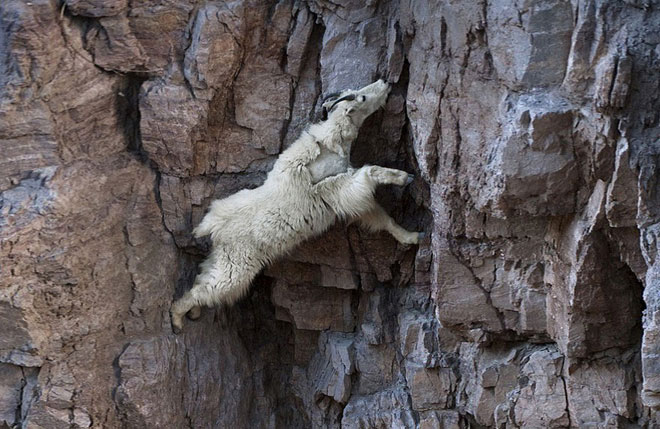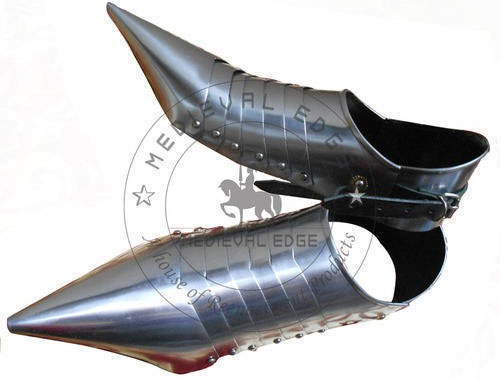Why do goats climb well?
There is one truth: goats climb very well, and certainly not goats know their meat is very good, so run to the mountains to hide. Someone wondered this question on Quora, and there was an excellent answer coming from Stefan Pociask , a wildlife researcher and writer of natural phenomena.
His answer was posted in leading newspapers, including the Huffington Post and Forbes. Here are the goat secrets that Mr. Pociask revealed:
All of the answers available on the Internet are obscure and do not satisfy anyone's curiosity. The data available on goats and set of goats are general, not specific. Now it is time to lift the secret screen, and the armor knights from the Middle Ages will give us a better understanding of the goat.
Many animals are known for their rock climbing abilities, most notably sheep and goats, but one is superior. Mountain goats are climbers without adversaries, when they reach frightening heights and at first glance, the cliffs they climb are impossible to cling to.

Mountain goats are climbers without adversaries.
Looking at them standing on the cliffs, there are only two big questions in my mind: ' How on earth do they climb up, and how on earth do they climb down?' . Besides, there are small questions such as: climbing all day like that is really good meat.
So what is the difference between mountain goats and other climbing species?Most are in the difference of the hooves , giving them excellent rock grip and additional anti-skid ability when standing on an inclined plane. To explain, it is possible to use hooves of goats to compare with the knight's armor, namely the armor in the foot .

These also have their own names, called 'sabaton'.
Both the design and function of these two 'nails' have similarities. The sabaton footprints had no soles, they were a layer of metal placed on the knight's shoes, forming a foot with hard armor on top and a soft base, wrapped around the soles that would be the hard edge to reach the face. land.

This is the basic design of animal hooves.
This is the 'device' that allows goats to climb cliffs. Looking at the horseshoe, for example, you will see them run by tapping the hems of the hooves onto the ground rather than running on the feet like people; The way to use this nail is why the metal nail for the horse is U-shaped.
Climbing goats combine the best elements of the best nails / feet: their hooves are both hard edges and soft soles .
Next, once again consider the horse's hooves: the horse has only one finger, with the border around the hard nail; The mountain lion has many fingers but no hard hooves around the edges. The mountain goat once again possesses the most quintessential parts of two legs : has many fingers, and has a hard edge to hold on to .
These factors allow them to adhere to the rock surface and retain their position even when standing on the slanted surface. This is an explanation, and first look at the hooves of the big horned sheep and watch:

The hooves of big horned sheep.
Look carefully, then compare with the basic design of the hooves mentioned above. The wrinkled part in the middle is the soft base, you can even see where the hard nail starts. When the nail is on the surface of a lot of stones, the exposed stones will press on the soft feet, then be locked up by the surrounding hard nail, making sure you never slip away.
Besides, two separate fingers can spread out to set foot for easy, or close tightly to grip the rock even more. Once the foot is placed on the stone, the hooves will ensure that the goat does not slip away, no matter how rough the rock surface is.

Two separate fingers can spread out to set foot for easy, or close tightly to grip the rock even more.
But the goats are also very careful in choosing their footing, even know to stick their feet out . to remove the stones to stand firm. Just being careful and born has genuine legs to climb, so how can it be? Saying that to get the feet and hooves like today, natural selection contributes a large part of the effort: do not know how many generations of goats have fallen to the foot of the mountain so that they can adapt to the day. today.
After every goat generation, they climb better. Just to eat, to avoid the eyes of the predator, every crime is easy to lose. Seeing that miraculous nature.

"What do you look at?"
This only partially answers the question, is how the goat clings to the rough and rocky surface. The way of climbing the goat will require capital knowledge of the forelimbs, shoulder muscles and other physiological factors. So please explain about going down the mountain first.
Still the same as before, it was mainly due to the design of the hooves , along with carefully choosing the place to put the foot and removing the rubble from the place you want to set foot. Besides, if the goats do not calculate before the way down, it will come down the mountain again in the same way as their ancestors did. They know there will be less optimal footing points, so you'll have to find a way to jump to safer points.
If necessary and if possible, the goat down the mountain will try to jump to the side, but jumping along the ridge only dies. If they jump to the side, the energy that comes from the goat's activity as well as the body weight will be thrown to the side rather than thrown down the foot of the mountain.

When going down the mountain, they will always maintain 3 contact points at all times.
When going down the mountain, they will always maintain 3 contact points at all times, as opposed to climbing (many research reports indicate that goats use one leg to lift the entire body weight). The way down is much more dangerous, when the momentum pulls them down to death, waiting especially high. So, not careful, lose your life.
Like every mountain climber, goats know they have to keep their focus as close to the rocky surface as possible.
They are all mountain climbing professionals, so why is the mountain goat superior, to honor the name of the "mountain goat"? First of all, this is a mountain goat's hooves:

Clogs of mountain goats.
We immediately see the difference with the claws of the big horned sheep: the soles of the feet have more tender and wider points, and the hard edges are like the sabaton in the knight's armor. The border has no curve but much more obvious. Thanks to the wide layer of meat, the goat will know immediately the surface of the stone when putting down its foot, to respond promptly to any possible situation.
Out of hooves, analyze the structure of mountain climbing specialists.
Starting with the most obvious part, it's the impressive horns of the big horned sheep and the alpine goat. The horns are big and beautiful, but will make the goat lose its balance when clinging to the cliff, and the horn of the goat's goat is a few times smaller; surely removing the weight at the top will make the mountain road much easier.

Mountain goat.

Sheep mountain.

Alps.
Next, look at the shape of the mountain goat, the bouncing muscles in the neck and shoulders will allow the goat to lift its body to the most craggy cliffs. It can reach places where few species reach.
When climbing a mountain, human five-legged feet cannot match the magic of nature.
- Surprise by the ability of mountain goats
- Fun fact about goat species makes you laugh without picking up your mouth
- Sheep-shaped goats of special appearance appear in the United States
- The festival of killing creepy goats in the world
- Goats like those who are smiling with them
- The 6-meter python swallowed the live captured goats
- Breeding for goats
- Surprise by the ability of mountain goats
- Two-headed goats in China
- Goats for milk like human milk
- Goat climbing in Morocco
- Video: The 'goat' herd is precarious
- Successful farming of genetically modified goats for cancer treatment
 Animal 'suffering' after hibernation
Animal 'suffering' after hibernation Scientists were surprised to see chimpanzees eating turtles
Scientists were surprised to see chimpanzees eating turtles Giant catfish died deadly due to drought in Thailand
Giant catfish died deadly due to drought in Thailand 10 most beautiful birds on the planet
10 most beautiful birds on the planet The magical cloud appeared on the top of Ba Den mountain (Tay Ninh), making people constantly excited.
The magical cloud appeared on the top of Ba Den mountain (Tay Ninh), making people constantly excited.  Setting up a camera in the forest, hunters were startled to find a creature that had been extinct for more than 100 years.
Setting up a camera in the forest, hunters were startled to find a creature that had been extinct for more than 100 years.  Are bald eagles strong enough to take down mountain lions?
Are bald eagles strong enough to take down mountain lions?  Why is 'China's smallest mountain' only 0.6m high but no one dares to climb it?
Why is 'China's smallest mountain' only 0.6m high but no one dares to climb it?  The hardest mountain in the world to climb, no one has ever reached the top and the failure rate is 100%
The hardest mountain in the world to climb, no one has ever reached the top and the failure rate is 100%  The mysterious 'man-swallowing' mountain has forced experts to intervene
The mysterious 'man-swallowing' mountain has forced experts to intervene 